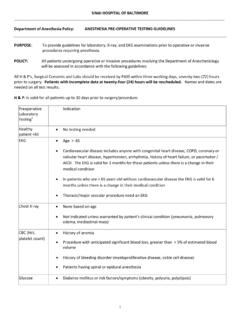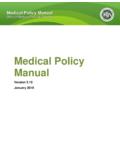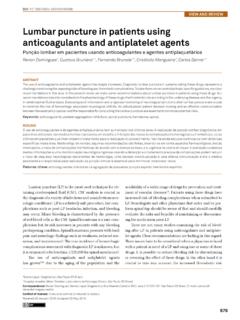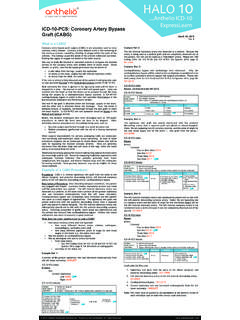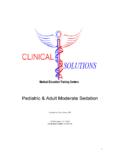Transcription of Regional Anesthesia in the Anticoagulated Patient: …
1 Regional Anesthesia in the Anticoagulated Patient: Defining the Risks (The Second ASRA. Consensus Conference on Neuraxial Anesthesia and Anticoagulation). Terese T. Horlocker, , Denise J. Wedel, , Honorio Benzon, , David L. Brown, , F. Kayser Enneking, , John A. Heit, , Michael F. Mulroy, , Richard W. Rosenquist, , John Rowlingson, , Michael Tryba, , and Chun-Su Yuan, , N euraxial Anesthesia and analgesia provide sev- eral advantages over systemic opioids, includ- ing superior analgesia, reduced blood loss and need published in the cardiology and neurology litera- ,9. In response to these patient safety issues, the Amer- for transfusion, decreased incidence of graft occlu- ican Society of Regional Anesthesia and Pain Medi- sion, and improved joint mobility following major cine (ASRA) convened its Second Consensus Confer- knee New challenges in the manage- ence on Neuraxial Anesthesia and Anticoagulation.
2 Ment of patients undergoing neuraxial block have Portions of the material presented here were pub- arisen over the last 2 decades, as medical standards lished as the proceedings of the 1998 ASRA Consen- for the prevention of perioperative venous throm- sus The information has been up- boembolism were ,6 Concern for pa- dated to incorporate additional data available since tient safety in the presence of potent antithrombotic the time of its publication. It is important to note that drugs has resulted in avoidance of Regional anesthe- although the consensus statements are based on a thorough evaluation of the available information, in sia.
3 Indeed, perioperative Anesthesia and analgesia some cases data are sparse. Numerous studies have are often determined by the antithrombotic documented the safety of neuraxial Anesthesia and Conversely, although the Anesthesia community is analgesia in the Anticoagulated patient. Unfortu- well aware of the potential for spinal bleeding, nately, with a complication as rare as spinal hema- other specialties have only recently become cogni- toma, no clinical study to date has sufficient power to zant of the risk, as documented by case reports definitively determine patient management. Conse- quently, the pharmacology of hemostasis-altering drugs and case reports of spinal hematoma are also See Editorial page 163 essential to Regional anesthetic management.
4 Vari- ances from recommendations contained in this docu- ment may be acceptable based on the judgment of the From the Department of Anesthesiology, Mayo Clinic ( , responsible anesthesiologist. The consensus state- , ), Rochester, Minnesota; Northwestern University ments are designed to encourage safe and quality ( ), Chicago, Illinois; University of Iowa ( , ), Iowa patient care, but cannot guarantee a specific outcome. City, Iowa; University of Florida ( ), Gainesville, Florida; Vir- ginia Mason Medical Center ( ), Seattle, Washington; Uni- They are also subject to timely revision as justified by versity of Virginia Health Science Center ( ), Charlottesville, evolution of information and practice.
5 Finally, the Virginia; Department of Anesthesiology, Intensive Care and Pain current information focuses on neuraxial blocks and Medicine ( ), Kassel, Germany; and Tang Center for Herbal Medicine Research, Department of Anesthesia and Critical Care, anticoagulants; the risk following plexus and periph- University of Chicago ( ), Chicago, Illinois. eral techniques remains undefined. Although sev- Accepted for publication January 29, 2003. eral case reports of vascular injury with (or without). Reprint requests: Terese T. Horlocker, , Department of Anesthesiology, Mayo Clinic, Rochester, MN, 55905. E-mail: resultant nerve dysfunction have been described,15,16.
6 Additional experience is needed to allow statements 2003 by the American Society of Regional Anesthesia and for non-neuraxial blocks. The current literature in- Pain Medicine. 1098-7339/03/2803-0004$ volving hemorrhagic complications of plexus and pe- ripheral block is included for completeness. 172 Regional Anesthesia and Pain Medicine, Vol 28, No 3 (May June), 2003: pp 172 197. Neuraxial Anesthesia and Anticoagulation Horlocker et al. 173. Table 1. Pharmacological Venous Thromboembolism Prophylaxis and Treatment Regimens and Treatment Regimens for Acute Coronary Syndromes Total Hip or Knee Replacement Thromboprophylaxis Adjusted-dose unfractionated heparin 3,500 U SC q 8 hours, started 2 hours before surgery; after surgery, the dose is adjusted to maintain the aPTT within the upper normal range Low molecular weight heparin Ardeparin sodium (Normiflow ) 50 U/kg SC q 12 h, started 12-24 hours after surgery Dalteparin sodium (Fragmin ) 5,000 U SC qd, started 12 hours before surgery, or 2,500 U SC given 7.
7 Hours after surgery, then 5,000 U SC daily Danaparoid sodium (Orgaran ) 750 U SC q 12 h, started 2 hours before surgery Enoxaparin sodium (Lovenox ) 30 mg SC q 12 h, started 12-24 hours after surgery, or 40 mg SC qd, started 10-12 hours before surgery Tinzaparin (Innohep ) 75 U/kg SC qd, started 10-12 hours before surgery Warfarin sodium 5 mg orally, started the night before or immediately after surgery and adjusted to prolong the INR General Surgery Thromboprophylaxis Unfractionated heparin 5,000 U SC q 8-12 hours, started 2 hours before surgery Low molecular weight heparin Dalteparin sodium 2,500 U SC qd, started 1-2 hours before surgery Enoxaparin sodium 40 mg SC qd, started 2 hours before surgery Acute Coronary Syndrome and Venous Thromboembolism Therapy Enoxaparin sodium 1 mg/kg SC q12 hours (outpatient DVT or non q-wave MI).
8 1 mg/kg SC q12 hours, or mg/kg SC qd (inpatient treatment of DVT. or PE). Dalteparin 120 U/kg q 12 hours or 200 U/kg qd (non q-wave MI). Tinzaparin 175 U/kg qd NOTE. Dosing recommendations from Beerts et Abbreviations: SC, subcutaneous; MI, myocardial infarction; aPTT, activated partial thromboplastin time; INR, international normalized ratio. Current Recommendations for the necessitates more aggressive antithrombotic (and Prevention and Treatment of Venous potentially thrombolytic) therapy. For example, Thromboembolism acute DVT/PE is treated with therapeutic anticoag- ulation with unfractionated or low molecular Thromboprophylaxis is based upon identification weight heparin (LMWH); thrombolytic therapy of risk factors.
9 Guidelines for antithrombotic ther- may also be utilized alone or concomitantly (Table apy including appropriate pharmacologic agent, de- 1). Likewise, the American College of Cardiology gree of anticoagulation desired, and duration of and American Heart Association Task Force on therapy continue to ,6 Recommendations Practice Guidelines for the Management of patients from the Sixth American College of Chest Physi- with Acute Myocardial Infarction recommends a cians (ACCP) Consensus Conference in 2001 are combination therapy of (1) aspirin or (2) ticlopi- based upon prospective randomized studies that as- dine/clopidogrel for patients with aspirin intoler- sess the efficacy of therapy using contrast venogra- ance, (3)
10 Therapeutic anticoagulation with unfrac- phy or fibrinogen leg scanning to diagnose asymp- tionated heparin or LMWH, and (4) administration tomatic thrombi (Table 1). Clinical outcomes, such of a platelet glycoprotein (GP) IIb/IIIa receptor an- as fatal pulmonary embolism (PE) and symptomatic tagonist. Intravenous (IV) thrombolytic therapy is deep venous thrombosis (DVT) are not primary recommended in patients with acute (less than 6. Despite the successful reduction of hours) These treatment modalities asymptomatic thromboembolic events with routine have a dramatic impact on the patient's ability to use of antithrombotic therapy, an actual reduction maintain hemostasis.
